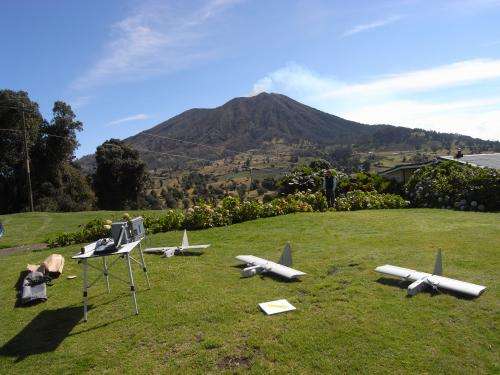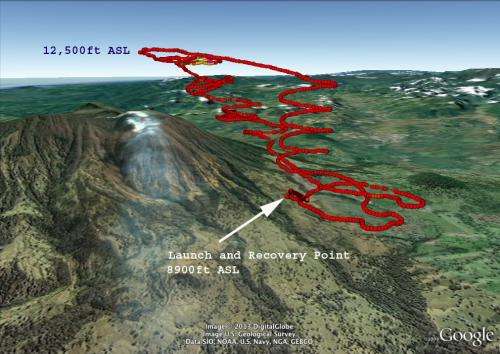NASA sends unmanned aircraft to study volcanic plume

(Phys.org) —Studying volcanos can be hazardous work, both for researchers and aircraft. To penetrate such dangerous airspace, unmanned aerial vehicles (UAVs), especially those with electric engines that ingest little contaminated air, are an emerging and effective way to gather crucial data about volcanic ash and gases.
Last month, a team of NASA researchers deployed three repurposed military UAVs with special instruments into and above the noxious sulfur dioxide plume of Costa Rica's active Turrialba volcano, near San Jose. The project was designed to improve the remote-sensing capability of satellites, including satellite data research products such as maps of the concentration and distribution of volcanic gases. It was also designed to improve computer models of how and where volcanic plumes will travel.
Led by principal investigator David Pieri of NASA's Jet Propulsion Laboratory, Pasadena, Calif., the team launched 10 flights of the remote controlled UAVs into the volcanic plume and above the rim of Turrialba's 10,500-foot (3,200-meter) summit crater between March 11 and 14.
The small, twin electric engine Dragon Eye UAVs were acquired by researchers at NASA's Ames Research Center, Moffett Field, Calif., from the United States Marine Corps. Weighing less than six pounds (2.2 kilograms) each and with a wingspan of 3.75 feet (1.1 meters), they have visible and infrared video cameras and can carry a one-pound instrument payload for up to an hour within a volcanic plume. The researchers equipped them with sulfur dioxide and particle sensors and automatic atmospheric sampling bottles keyed to measure sulfur dioxide concentration.

During the flights, the team coordinated its data gathering with NASA's Advanced Spaceborne Thermal Emission and Reflection Radiometer (ASTER) instrument on NASA's Terra spacecraft, allowing scientists to compare sulfur dioxide concentration measurements from the satellite with measurements taken from within the plume.
Scientists believe computer models derived from this study will contribute to safeguarding the National and International Airspace System, and will also improve global climate predictions and mitigate environmental hazards (e.g., sulfur dioxide volcanic smog, or "vog") for people who live near volcanoes.
A key constituent of such models is the intensity and character of the volcanic activity located near the eruption vent. For instance, knowing the height of ash and gas concentrations, and temperatures over the vent during an eruption are important initial factors for any model that predicts the direction of the volcanic plume.
"It is very difficult to gather data from within volcanic eruption columns and plumes because updraft wind speeds are very high and high ash concentrations can quickly destroy aircraft engines," said Pieri. "Such flight environments can be very dangerous to manned aircraft. Volcanic eruption plumes may stretch for miles from a summit vent, and detached ash clouds can drift hundreds to thousands of miles from an eruption site."
The project supports NASA's ASTER mission as well as JPL's planned Hyperspectral Infrared Imager (HyspIRI) satellite mission by improving satellite data-based retrievals of gases and solid aerosols associated with volcanic activity, as well as volcanic emission transport models. HyspIRI will study the world's ecosystems and provide critical information on natural disasters such as volcanoes, assessing their pre-eruptive behavior and the likelihood of future eruptions.
More information: For more information, read the full Ames feature at: www.nasa.gov/topics/earth/eart … anic-plume-uavs.html . For more on NASA's Airborne Science Program, visit: airbornescience.nasa.gov/ . For more on HyspIRI, visit: hyspiri.jpl.nasa.gov/ . For more on ASTER, visit: asterweb.jpl.nasa.gov/ .
Provided by NASA













.jpg)





